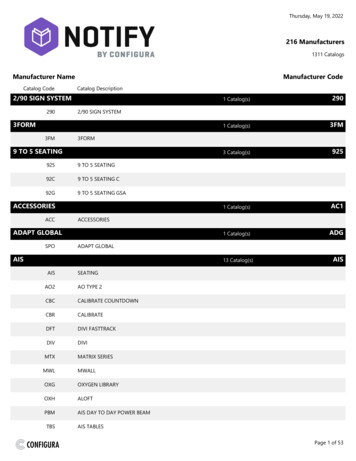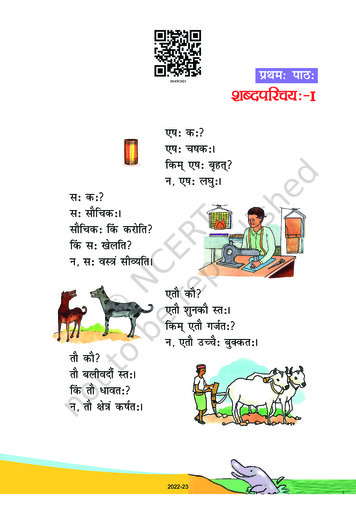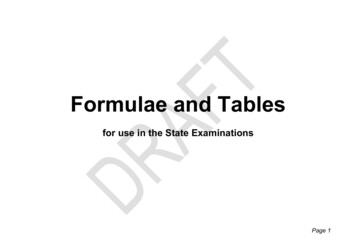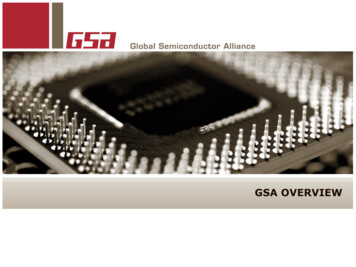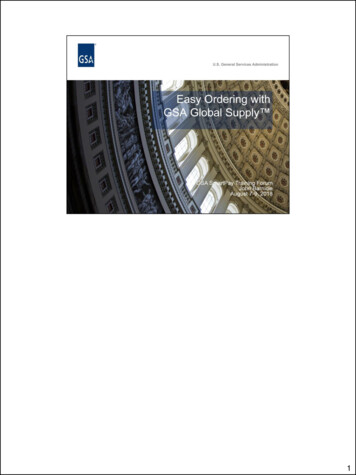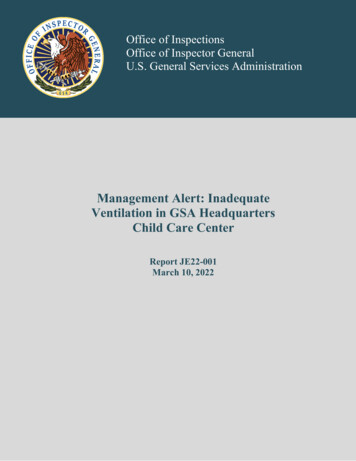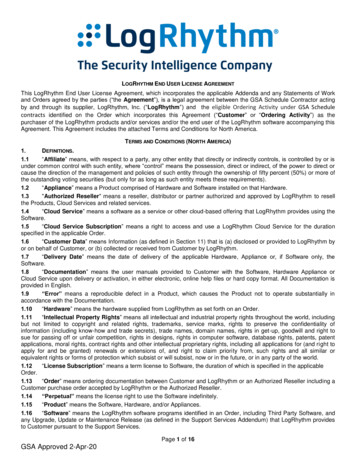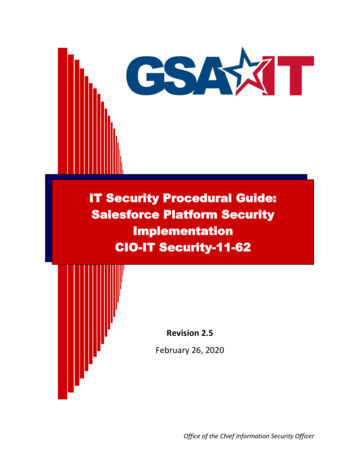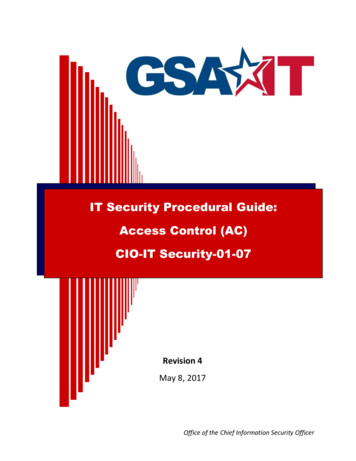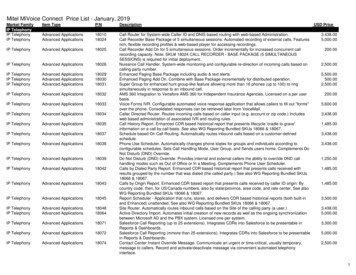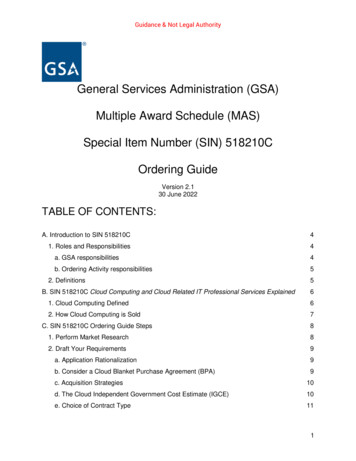
Transcription
Guidance & Not Legal AuthorityGeneral Services Administration (GSA)Multiple Award Schedule (MAS)Special Item Number (SIN) 518210COrdering GuideVersion 2.130 June 2022TABLE OF CONTENTS:A. Introduction to SIN 518210C41. Roles and Responsibilities4a. GSA responsibilities4b. Ordering Activity responsibilities52. DefinitionsB. SIN 518210C Cloud Computing and Cloud Related IT Professional Services Explained561. Cloud Computing Defined62. How Cloud Computing is Sold7C. SIN 518210C Ordering Guide Steps81. Perform Market Research82. Draft Your Requirements9a. Application Rationalization9b. Consider a Cloud Blanket Purchase Agreement (BPA)9c. Acquisition Strategies10d. The Cloud Independent Government Cost Estimate (IGCE)10e. Choice of Contract Type111
Guidance & Not Legal Authorityf. Authorized Reseller vs. CSP (direct)14g. Multi-Cloud Strategy for IaaS and PaaS?14h. Cloud Computing as a Set Aside?15i. FedRAMP15j. Term Services and Period of Performance (PoP) Alignment17k. Additional Available Resources173. Governance194. Fund the Acquisition205. Issue a Solicitation21a.eBuy:21b.SAM.gov:216. Evaluation of Responses217. Make an Award22Appendix A: GSAR Clause 552.238-19923Appendix B: Examples of Consumption Based Ordering272
Guidance & Not Legal AuthorityDisclaimer of Liability or Endorsement:The U.S. General Services Administration (GSA) expressly disclaims liability for errors and omissions inthe contents of this document. No warranty of any kind, implied, expressed, or statutory, including butnot limited to the warranties of non-infringement of third party rights, title, merchantability or fitness for aparticular purpose, is given with respect to the contents of this document or its links to other Internetresources.The information appearing in this document is for general informational purposes only. Reference inthis document to any specific activity (e.g., event, meeting, training), commercial product, process, orservice, or the use of any trade, firm or corporation name is for the education, information, andconvenience of the government and public, and does not constitute endorsement, recommendation, orfavoring by GSA.GSA does not control or guarantee the accuracy, relevance, timeliness, or completeness of informationcontained on a website linked to by this document; does not endorse the organizations sponsoring anylinked websites; does not endorse the views they express or the products/services they offer; cannotauthorize the use of copyrighted materials contained in linked websites. Users must request suchauthorization from the sponsor of the linked website.3
Guidance & Not Legal AuthorityA. Introduction to SIN 518210CThe GSA Multiple Award Schedule (MAS) are long-term governmentwide contracts withcommercial firms providing federal, state, and local government buyers access to more than 11million commercial supplies (products) and services at volume discount pricing.MAS contains the Special Item Number (SIN) 518210C, Cloud Computing and Cloud RelatedInformation Technology (IT) Professional Services, specifically for just cloud services authorizedvendors. SIN 518210C may be utilized by federal Ordering Activities as well as state, local,tribal organizations, certain educational institutions, international organizations, and othereligible users outlined in GSA Order OGP 4800.2I.SIN 518210C contains over four hundred authorized vendors of cloud computing services as ofJune 2022, and growing. It also includes cloud related IT professional (labor) services.Therefore, Ordering Activities may solicit to contractors providing SIN 518210C on theirschedule contract to find cloud services and cloud related IT cloud professional services (labor).SIN 518210C contains only cloud services that meet the National Institute of Standards andTechnology (NIST) definition of cloud. When multiple requirements are needed, OrderingActivities should only select SIN 518210C when submitting a RFQ on eBuy and state thatauthorized contractors may utilize other SINs to create a complete solution. Examples would besoliciting the Software SIN (SIN 511210) for software that is not cloud based (and so does not fitthe NIST definition) but runs in the cloud and/or manages other cloud offerings, or theHardware SIN (SIN 33411) for private cloud requirements since no hardware for private cloudsis listed on the SIN 518210C.This SIN 518210C Ordering Guide will only provide guidance to Ordering Activities. It will notprescribe or limit what cloud services contractors provide, nor is it binding to Ordering Activitiesas they will have to execute in accordance with their Ordering Activity policies and practices.This Guide is intended to be a living document and will be updated periodically, as needed.For a deeper discussion of the topics discussed in this guide, please refer to the GSA MASDesk Reference.1. Roles and ResponsibilitiesGSA is responsible for the award, administration, and management of the GSA Multiple AwardSchedule (MAS) Solicitation and the Information Technology Category Attachment to theSolicitation. The Ordering Activity is responsible for the award, administration, management,and closeout of task orders placed against the GSA MAS Contract and compliance with itsterms and conditions, the Federal Acquisition Regulation (FAR), and local Ordering Activitypolicies, as applicable.a. GSA responsibilities Administer the GSA MAS Information Technology Category, including annualsubcontracting goal reporting, contract modifications to implement new FAR guidance,and updating the terms and conditions.4
Guidance & Not Legal Authority Provide advice and guidance to Ordering Activities regarding specific cloud acquisitionmatters, by emailing the GSA Cloud Team at cloudinfo@gsa.gov.Determines “fair and reasonable” prices and ceiling prices for a single unit whenawarding GSA contracts.b. Ordering Activity responsibilities Define order requirements (technical, security, operational, workflow, functional, etc.),including evaluation criteria.Prepare requirements documents for solicitations against contracts. This includes aStatement of Work (SOW) or Performance Work Statement (PWS) for task orders (TO)and product listings and other necessary information for delivery orders (DO).Properly manage funds in accordance with (IAW) appropriation laws and their OrderingActivity rules and regulations.Evaluate quotes IAW the Federal Acquisition Regulation (FAR) and the Ordering Activitydefined evaluation criteria.Monitor performance, including appointing a Contracting Officer’s Representative (COR)when applicable.Negotiate pricing, discounts, and other Simplified Acquisition Threshold (SAT) pricingwith authorized vendors when applicable.2. Definitions Ordering Activity Contracting Officer (OACO): the Ordering Activity warrantedContracting Officer (CO) placing the order.Office of the Chief Acquisition Officer (OCAO): the team responsible for developing andreviewing acquisition policies, procedures and related training for the Ordering Activity.GSA Contracting Officer (CO): a person with the authority to enter into, administer,and/or terminate contracts and make related determinations and findings. The GSACO administers the GSA MAS contract.Special Item Number (SIN): the unique identification number assigned to specificproduct or service categories under the GSA MAS Solicitation.Contractor Team Arrangement (CTA): two or more GSA MAS authorized contractorsworking together to provide a total solution to the Ordering Activity, whereby each isworking under their respective GSA MAS contract awards. This is not a prime/subarrangement. See www.gsa.gov/cta for more information.Ordering Activity: a federal, state, or local government Ordering Activity or other eligibleentity that is authorized to use SIN 518210C.Cooperative Purchasing Program: authorized Ordering Activities, per 40 U.S.C. 502(c),may leverage SIN 518210C under the GSA Cooperative Purchasing Program. Eligibilityto use GSA Sources of Supply.Disaster Purchasing Program: authorized Ordering Activities, per 40 U.S.C. 502(c), mayleverage SIN 518210C under the GSA Disaster Purchasing Program to facilitate disasterpreparation, response, or major disaster recovery.Authorized Reseller: an entity that has been contractually authorized by a cloud serviceprovider (CSP) to act as an authorized agent or intermediary cloud broker to offer,negotiate, and sell, on the behalf of the CSP, the CSP's cloud services.5
Guidance & Not Legal Authority Authorized Contractor: an entity that has been awarded SIN 518210C Cloud Computingand Cloud Related IT Professional Services on their GSA MAS award. An authorizedvendor can be either a CSP or an authorized reseller.Cloud Service Provider (CSP): an entity that directly operates and manages the cloudservices (i.e., IaaS, PaaS, SaaS) technology (e.g., facility, hardware, software).B. SIN 518210C Cloud Computing and CloudRelated IT Professional Services Explained1. Cloud Computing DefinedFor this document we use the definition of "cloud" by the National Institute of Standards andTechnology (NIST) Special Publication 800-145 The NIST Definition of Cloud Computing.Traditionally an Ordering Activity would purchase hardware and/or software infrastructureoutright as well as unboxing it, racking, stacking and wiring it, configuring it, etc. With cloudcomputing, an Ordering Activity remotely orders virtual machines, applications and more at thetouch of a button.The National Institute of Standards and Technology (NIST) definition of cloud computing isbroken down into these five distinct characteristics: On Demand Self Service – A consumer can unilaterally provision computing capabilities, suchas server time and network storage, as needed automatically without requiring humaninteraction with each service provider.Rapid Elasticity – Capabilities can be elastically provisioned and released, in some casesautomatically, to scale rapidly outward and inward commensurate with demand. To theconsumer, the capabilities available for provisioning often appear to be unlimited and can beappropriated in any quantity at any time.Broad Network Access – Capabilities are available over the network and accessed throughstandard mechanisms that promote use by heterogeneous thin or thick client platforms (e.g.,mobile phones, tablets, laptops, and workstations).Resource Pooling – The provider’s computing resources are pooled to serve multipleconsumers using a multi-tenant model, with different physical and virtual resources dynamicallyassigned and reassigned according to consumer demand. There is a sense of locationindependence in that the customer generally has no control or knowledge over the exactlocation of the provided resources but may be able to specify location at a higher level ofabstraction (e.g., country, state, or datacenter). Examples of resources include storage,processing, memory, and network bandwidth.Measured Service – Cloud systems automatically control and optimize resource use byleveraging a metering capability at some level of abstraction appropriate to the type of service(e.g., storage, processing, bandwidth, and active user accounts). Resource usage can bemonitored, controlled, and reported, providing transparency for both the provider and consumerof the utilized service.To be considered cloud computing by this definition, the cloud service must possess all of theabove five characteristics.6
Guidance & Not Legal AuthorityThere are three primary cloud service models you can purchase: IaaS (Infrastructure as a Service) – The capability provided to the consumer is to provisionprocessing, storage, networks, and other fundamental computing resources where theconsumer is able to deploy and run arbitrary software, which can include operating systems andapplications. The consumer does not manage or control the underlying cloud infrastructure buthas control over operating systems, storage, and deployed applications; and possibly limitedcontrol of select networking components (e.g., host firewalls).PaaS (Platform as a Service) – The capability provided to the consumer is to deploy onto thecloud infrastructure consumer-created or acquired applications created using programminglanguages, libraries, services, and tools supported by the provider. The consumer does notmanage or control the underlying cloud infrastructure including network, servers, operatingsystems, or storage, but has control over the deployed applications and possibly configurationsettings for the application-hosting environment.SaaS (Software as a Service) – The capability provided to the consumer is to use theprovider’s applications running on a cloud infrastructure . The applications are accessible fromvarious client devices through either a thin client interface, such as a web browser (e.g., webbased email), or a program interface. The consumer does not manage or control the underlyingcloud infrastructure including network, servers, operating systems, storage, or even individualapplication capabilities, with the possible exception of limited user specific applicationconfiguration settings.You must also choose a deployment model. Deployment models detail how many separate,multi-tenants are in the cloud environment and what the relationship between these tenants is.There are four NIST cloud deployment models: Public Cloud – The cloud infrastructure is provisioned for open use by the general public. Itmay be owned, managed, and operated by a business, academic, or government organization,or some combination of them. It exists on the premises of the cloud provider.Private Cloud – The cloud infrastructure is provisioned for exclusive use by a singleorganization comprising multiple consumers (e.g., business units). It may be owned, managed,and operated by the organization, a third party, or some combination of SIN 518210C.Community Cloud – The cloud infrastructure is provisioned for exclusive use by a specificcommunity of consumers from organizations that have shared concerns (e.g., mission, securityrequirements, policy, and compliance considerations). It may be owned, managed, andoperated by one or more of the organizations in the community, a third party, or somecombination of them, and it may exist on or off premises.Hybrid Cloud – The cloud infrastructure is a composition of two or more distinct cloudinfrastructures (private, community, or public) that remain unique entities, but are boundtogether by standardized or proprietary technology that enables data and application portability(e.g., cloud bursting for load balancing between clouds).2. How Cloud Computing is SoldMost of the cloud computing pricing models require careful analysis by Ordering Activity personnelbased on the unique attributes of their acquisition. Many pricing models require ongoing monitoring ofusage and available funding. See the discussion on choosing contract types later in this document forguidance on using a not-to-exceed (NTE) ceiling price by CLIN.7
Guidance & Not Legal Authority IaaS/PaaS priced by the Increment (e.g., transaction, Minute, Seconds, Hours or Days), forcentral processing units (CPUs), storage or memory for virtual machines in the cloudenvironment. Depending on the contract type awarded, this may cause invoices to vary frommonth to month. In the case of communications application programming interface (API)platforms that charge by short message service (SMS) message/email sent or voice minutesused.SaaS priced by the Seat (e.g., application user seat), most commonly by the seat per month orseat per year.SaaS priced by the Transaction (e.g., up/download, operation), as in the case of large onlinedatabases. Login may or may not be free of charges, but a per transaction charge accrueswhenever the customer issues a query against that large database (e.g., real estate or scientificapplications). Another example, for SaaS, might be a charge for each read/write disk operation,sometimes sold in dollars per 10M operations, etc.IaaS/PaaS priced by Data Transport, is calculated from the transport of data into/within/out ofthe data center.IaaS/PaaS priced by Service Term (e.g., time period), sometimes called “reservations,”“reserved instances” (RIs), “committed use” or “savings plans”, each CSP has their own specificterm for the offering. For the purpose of this document we will refer to them as the genericterm “cloud reservations”. These are commitments to purchase compute capacity, or bucketsof transactions, needed for your Ordering Activity over a defined and agreed to period of time,usually in exchange for a discount. Cloud reservations are allowed per the GSA MASSolicitation, as long as they are paid for in arrears (31 U.S.C. 3324). They are recommended forworkloads that have steady or predictable usage patterns. These “cloud reservations” offer adiscount against on-demand pricing (per minute, etc.) depending on length of term, whereasvolume discounts offer a tiered discount that depends on certain thresholds.C. SIN 518210C Ordering Guide Steps1. Perform Market ResearchThere are many ways to perform market research: GSA’s Market Research as a Service(MRAS), Small Business Administration (SBA) resources, Defense Acquisition University (DAU)resources, etc. You are encouraged to look at the options that align with your Ordering Activity’sneeds.GSA’s Market Research as a Service (MRAS) Tool lessens much of the frustration that the back andforth market research process may have. MRAS utilizes the latest automated research techniques tocollect authorized vendor response data. This no-cost service cross-indexes Ordering Activityrequirements against authorized contractors on SIN 518210C that support cloud.To initiate a MRAS, an Ordering Activity will:1. Engage their GSA Customer Service Director (CSD): Contact your CSD whowill help guide you through this process.2. Request a Scope Review: The GSA CSD and the Subject Matter Experts(SMEs) for the applicable GSA vehicle will review the requirement to determine ifit is within scope of one of the various GSA contracts (GovernmentwideAcquisition Contract (GWAC), OASIS, MAS, VETS2, etc.).8
Guidance & Not Legal Authority3. Request a Request for Information (RFI) from MRAS team: The GSA CSDand Ordering Activity will together fill out a short requirements questionnaire sothat the MRAS team can create a RFI.GSA will then publish a market research RFI on behalf of the Ordering Activity, allowing GSA togather authorized contractor responses for an agreed upon period of time. After that timeelapses, GSA collects and collates the results and delivers a report to the Ordering Activity. Thereport details the total number of interested authorized contractors, their relevant GSA contractsspecific to the requirements, their socioeconomic profiles, their business size, their responses tospecific yes/no technical questions, and more. Check out full MRAS samples here (A, B).The responses gathered from the market research may cause you to rethink choices of contracttype and other requirements. In that case you must loop back to revise your requirements.2. Draft Your Requirementsa. Application RationalizationThe authorized Ordering Activity should first complete the Application Rationalization(AppRat) process. This typically includes: inventorying the digital environmentassessing which applications are cloud ready and which are notdetermining which are high strategic business valuediscovering which are underutilizedseeing which should be kept and which should be retiredfinding system/services inter-decencies required supporting services/dataOnce the Application Rationalization process has been completed, it is time for theprogram/technical team, along with the acquisition team, to draft the formal cloudservices requirements and acquisition strategy.If an Ordering Activity chooses to use cloud professional services for the ApplicationRationalization process, it is recommended to do this as a standalone award, and thatdeliverable becomes the requirements for a second award to execute the migration to aCSP’s cloud. Also, the authorized Ordering Activity can require demonstratedexperience with similar size, scope, and subject matter expertise of projects, withapplicable CSP certifications, if available.b. Consider a Cloud Blanket Purchase Agreement (BPA)Ordering Activities can award BPAs (FAR 8.405-3) against the GSA MAS SIN 518210C.Ordering Activities award BPAs (i.e., multiple award or single award (see limitations: GSA, FAR8.405-3)) when an authorized Ordering Activity defines requirements (e.g., business,operations, security, technical) that allow the authorized Ordering Activity to issue BPA awardsto authorized contractors that meet the BPA requirements. The authorized Ordering Activity,and other authorized Ordering Activities, can then use the BPA to compete TOs against theBPA awardees. The TOs inherit the BPA requirements and can include additional requirementsor further define and delineate the requirements (e.g., quantities). An awarded TO results in the9
Guidance & Not Legal Authoritylegally binding "contract" between the Ordering Activity and the authorized contractor. (Note:Per FAR 8.405-3, they are referred to as TOs, not Orders, as SIN 518210C is a service, not aproduct.) When any TO is created, decisions about contract type and funding type could bemade at that time depending on the nature of the cloud computing requirement.c. Acquisition Strategies Distributed/Office Level: Supports a distinct and individual TO for specific, defined, and knownset of requirements.Here, the cloud services acquisition journey begins with what can be the most difficult step forsome: defining your cloud service requirements. Requirements must be developed for eachapplication so that they can be cloud-migrated or cloud-developed (i.e, ApplicationRationalization). The result is that the target cloud architecture is defined for each applicationbefore it is migrated to the appropriate/available cloud environment(s). This structured projectprocess is no different from a non-cloud project. Enterprise/Chief Information Officer (CIO) Level: Development of a BPA that definesbaseline requirements for specific recurring needs of an Ordering Activity with TO(s) awardedunder the BPA for specific quantities and deliverable times.Here the cloud services acquisition journey begins with reviewing current OrderingActivity cloud utilization and defining the overall goals and objectives of establishing anenterprise-wide purchasing vehicle (centralization, governance, risk management, costsavings, etc.). Other acquisition strategies to consider: Best practice is to separate the procurement of cloud services (IaaS, PaaS,SaaS) from the cloud related IT professional services (labor) often associatedwith the cloud (e.g., architecting, migration, configuration etc.). Awarding the ITprofessional services to a different Authorized Contractor may provide unbiasedsupport. This provides the greatest flexibility in utilizing in-house resources(Ordering Activity or contractor) with the best knowledge of existing systems fordelivering professional services. Before seeking to leverage emerging technologies, conduct due diligence toensure the likelihood of success. Untested emerging technologies may not meetearly expectations for performance or may not integrate into Ordering Activityoperations as initially anticipated. Ordering Activities should evaluate whichservices are available that meet Ordering Activity/federal security requirements.d. The Cloud Independent Government Cost Estimate (IGCE)The primary way in determining if "a price is reasonable'' is to develop a cost estimate(e.g., IGCE) and evaluate proposals in comparison to the developed cost estimate. TheOrdering Activity should check with their own internal supplemental acquisitionregulations, policies, and the FAR to understand if an IGCE is required for their specificcloud services procurement. Typically, the Ordering Activity must first estimate the value10
Guidance & Not Legal Authorityof the acquisition and if that estimated value exceeds the Simplified AcquisitionThreshold (SAT), then they are required to conduct market research.An IGCE is a complex undertaking for cloud services as individual cloud stock keepingunits (SKUs) need to be compared in an apples-to-apples way since they are sometimestied to a specific authorized contractor. If available, universal product codes (UPCs)should be used at the CSP level when comparing products. Best practice is to ask theCSP or authorized reseller the structure of their cloud service offerings and how theymap across their commercial cloud services ecosystem.Another suggestion is to create a set of technical requirements for the entire portfolio ofOrdering Activity applications to be hosted in the cloud. Then, visit the websites ofseveral CSPs and use the CSPs’ online calculators to help create the IGCE. Thecalculators provide public pricing that can be used in conjunction with other sources forcompiling an IGCE. These calculators are another tool in an Ordering Activity’s tool kit,but Ordering Activities should also attempt to find other ways to INDEPENDENTLYestimate costs. Note: not all CSPs price their solutions in the same manner; it isimportant to clearly understand how each CSP prices offerings, costs elements and noncost elements. It takes time to research, understand, and map those elements to yourIGCE.When performing a price analysis during market research, consider an approach withemphasis on pursuing volume discounts (which may be a tiered set of discounts basedon volume vs. fixed discounts) and enterprise-wide pricing. Ordering activities canmaximize cost savings by driving Ordering Activity cloud service customers toward anenterprise-wide cloud computing ordering approach (e.g., two-three Ordering Activitywide cloud orders or BPAs managed by one program office) instead of each programoffice issuing individual orders for cloud computing. Similarly, consolidating various ITservices under fewer contracts can also generate volume discounts. Like with any otherproduct or service, true savings for cloud computing is realized when customerscombine their cloud services requirements and leverage their buying power as a largevolume customer. The Ordering Activity CIO (under Federal Information TechnologyAcquisition Reform Act (FITARA)) has to approve these actions to ensure enterpriselevel deployment.e. Choice of Contract TypeThe contract type suggestions below are for GSA MAS Solicitation cloud services (e.g.,IaaS, PaaS, SaaS) plus associated tools for automated managed services which areoften billed as SaaS. The choice of contract type (i.e., fixed price, labor, or time-andmaterial) for cloud related IT professional services (work performed by humans), shouldbe considered separately. To learn more, please reference the “GSA Multiple AwardSchedule Ordering Guide Quick Reference Summer 2020”.It’s important that the Ordering Activity identifies if the cloud services will have a baselineutilization that does not fluctuate over the period of performance, or if utilization will havehigh fluctuation/surge that would benefit from consumption/utilization-based pricing. Thiswill guide your choice of contract type.11
Guidance & Not Legal Authority Requirements Type Task Orders: As discussed in the GSA Acquisition Letter (AL) MV21-06, Procurement of Cloud Computing on a Consumption Basis under the FederalSupply Schedule (FSS) program, GSA proposed a requirements task order framework tobuy cloud on a consumption basis, and proposed facilitating incremental funding viaoptional CLINs. (see Appendix A for General Services Acquisition Regulation (GSAR)Clause 552.238.199 Special Ordering Procedures Applicable when Procuring CloudComputing on a Consumption Basis (MAR 2022) and an example in Appendix B). Thistask order type is appropriate when the authorized Ordering Activity anticipates recurringrequirements but cannot predetermine the precise quantities of cloud computingservices that designated government activities will need during a definite period.NOTE: The special ordering procedures clause (GSAR Clause 552.238.199 SpecialOrdering Procedures Applicable when Procuring Cloud Computing on aConsumption Basis (MAR 2022)) is only required, per (c)(1), "when placing anincrementally funded task order under this contract for cloud computing serviceson a consumption basis." Otherwise, the clause is optional. Nothing in GSAR552.238-199 shall be construed to supersede the Ordering Activity’s contractfunding policies (GSAR 552.238-199(f)(3)) Consumption Framework Ordering activities can do this today but current policies don’t provide aroadmap for how to implement a consumption framework. Per GSA’sAcquisition Letter (AL) MV-21-06 Supplement 1, dated March 18, 2022,adding GSAR Clause 552.238-199 into the MAS Solicitation allowsOrdering Activities to use a “requirements type task order” contract type,which is a “task order that provides for filling all actual purchaserequirements of a designated authorized Ordering Activity during aspecified contract period, with performance by the Contractor beingscheduled when the authorized Ordering Activity awards, or exercisesoptions for, individual contract line items (CLINs) under the task order.” Well defined requirements lend themselves to the obligation of funding ona contract upfront, while unpredictable requirements might best be fundedusing optional CLINs that are funded at time of activation. But the corebenefits of cloud include on-demand self-service and rapid elasticity,which supports agile development, DevOps, and unforeseen spikes indemand. If your requirements aren’t well defined, consider establishingpredefined requirements on CLINs to be used later.Incremental Funding The Antideficiency Act requires that whenever an Ordering Activity entersinto a contractual obligation it must
A. Introduction to SIN 518210C 4 1. Roles and Responsibilities 4 a. GSA responsibilities 4 b. Ordering Activity responsibilities 5 2. Definitions 5 B. SIN 518210C . Cloud Computing and Cloud Related IT Professional Services Explained. 6 1. Cloud Computing Defined 6 2. How Cloud Computing is Sold 7 C. SIN 518210C OrderingGuide Steps 8 1.
